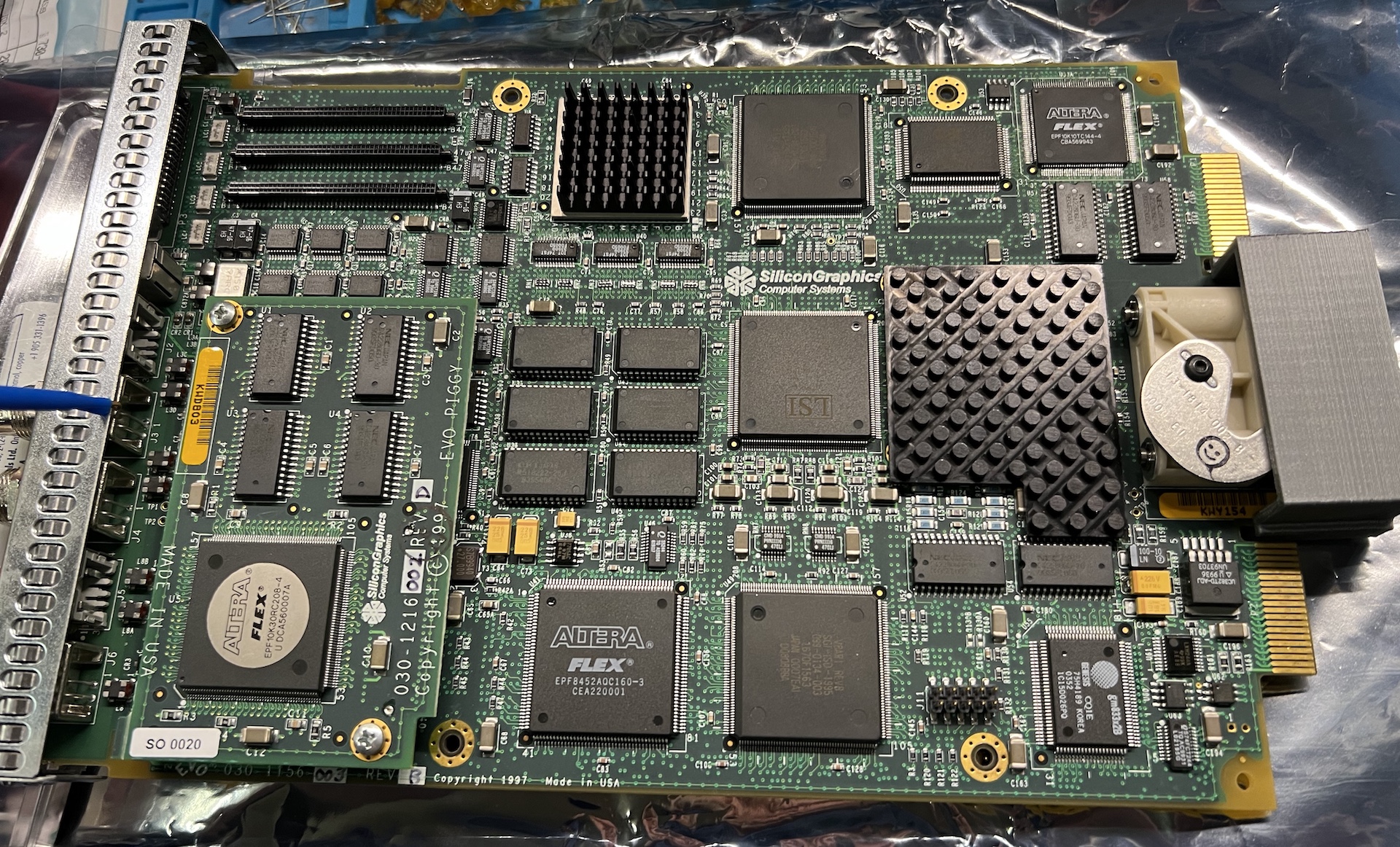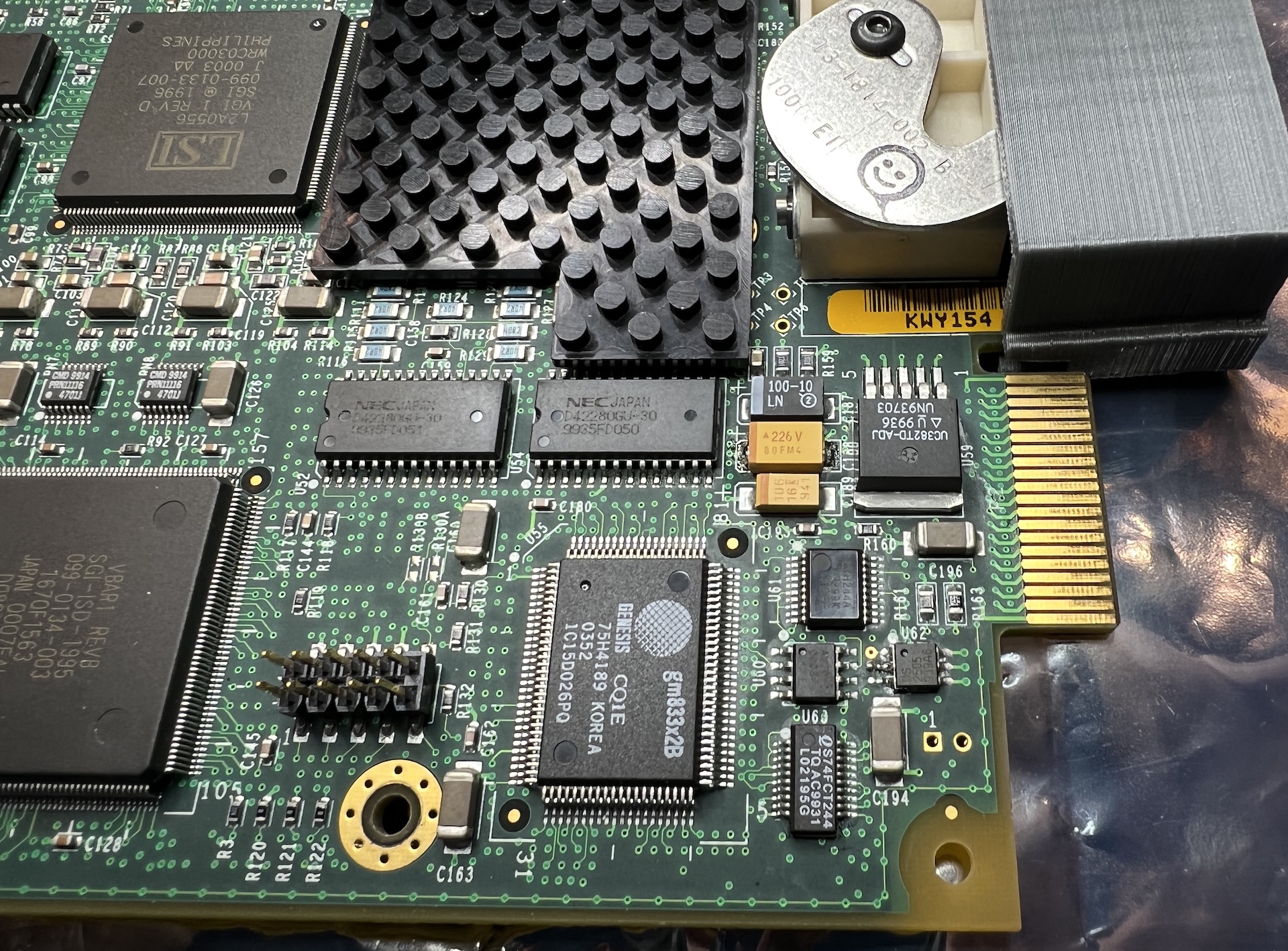Hi All,
Long time no post...sorry, real life getting in the way...I'll try prevent that. I'm posting today because of essentially a donation that was given to me for the cost of shipping by Geoman. We both live in different countries but shipping proved to be very reasonable and Geoman was nice enough to contact me and offer this board. I of course accepted because I just bought an Octane2, dual 400Mhz, system from Raion last year-ish, and this would totally rock in that. Geoman offered it to me because the board doesn't work, he'd tried a few things himself but in the end it didn't solve the symptoms, so it ended up on a shelf for a few years and he decided to let it go and see if someone could fix it and give the board it's own 15 minutes of fame.
Challenge accepted!
The board is 030–1156–003 rev B with mounted daughtercard 030–1216–002 rev D
He shipped it to me and I received it about a week ago (from this posting) and even though I don't really have the Octane PSU rebuilt or setup now...I wanted to start the basic process of troubleshooting the board now to be fair to Geoman's offer and give me something to post. Now understand that even if I solve the issue..we may not know for some time if it fully works because I have to drag my Octane2 out (hope it doesn't exploded from non-rebuilt PSU) and install the card, and see if the immediate symptom subsides...to check that it works...I'm going to be difficult and demand you guys wait unit I've rebuilt one Octane PSU so I feel safe reinstalling Irix and testing the system and then I can do video capture) to test it fully. That won't happen immediately...but I CAN test the symptom in PROM. So I'm willing to go that far without a parachute (rebuilt PSU). Please understand...but I WILL eventually get there and we'll have the full answer.
Anyway Geoman described the symptoms and what he did so far. I hope I'm getting this right. Geoman - If I leave anything out please feel free to correct me and I'll correct this post.
The described behavior was as follows: He got the card years ago (I assume this problem happened from the moment he came into possession of it has he didn't indicate he had it working at one point) and after mounting it to the XIO carrier and physically inserting the carrier into his Octane system...it would fail to boot, power-on, run, show any life at all, dead. When he removes the board...system starts fine, springs to life on power-on...no issues. Put the board back in...Octane dead as doorstop.
Geoman said he new something had shorted so he changed caps "C69, C47, C48, C188, ceramic/smd capacitors, 1:1 type, original Kemet" but that had no effect on the symptoms. He also noted a (possibly purposeful mod by the factory) that the daughter card (named EVO Piggy) has pin 134 cut off on the flex cable. It looked clean so it made be a factory/design thing.
I'd love it if someone with the same board can please CONFIRM that that trace for pin 134 is suppose to be cut (or it is on theirs). I'll get more info when I can on that...but we'll hope for now it's factory, on purpose.
Also could someone please take good high-res pics of their board for my visual comparison...I'll post pics I have but I'd love to visually compare a few things to make sure. So that would be extremely helpful.

I didn't bother much with the back of the PCB for now as I have enough on the front to give me my next steps.
Okay so this sounds like a classic main power rail shorted to ground...and luckily the Octane system is smart enough to figure this out without exploding!!! So that's good too.
Going into DIODE test mode on my multimeter I randomly checked any caps I could tell have been replaced and whatever else I found. I found caps C188, C105, C65, C196, C187, & C194 shorted (not an exhaustive test) so I stopped there. Now what I mean is an in-place test...so all that means in something attaching main power and ground is shorted and those same caps are also on that path...doesn't mean the above listed caps are shorted...just yet. There are other ways of testing which (if any) caps are shorted (later).
With such an overwhelming number of shorted areas spotted it was clear that the focus should be more towards the main power edge connector.

Main power has many shorted readings around it so maybe it's more local to the connector...but I've not done other tests so I'm not 100% on that of course...just the density of bad readings increased. Also most neighboring pins on the edge connector for board power are shorted together with a small voltage drop as they are arranged in alternating power/ground groups.
Okay, so what have we learned here. We know for 100% that one or more of the MAIN power rails that come directly into the card are shorted, I didn't see any explosive residue or evidence of a catastrophic failure so more than likely...it's a small component acting as a board heater...sucking power right off the main line. We also know that the issues wasn't among the caps originally changed during the initial repair...but again that's a drop in the pond.
Okay this is the issue I had hoped for when I agreed to take the unit because it's an obvious issue, in your face and not subtle or intermittent. So hopefully the problem is also that obvious. Now anything that's programmable and damaged will be disastrous...but my gut says...it's not going to be a special processor or programmable elements, it's either a cap or voltage regulator (LDO) on that rail that went.
There's a slow way and a fast way to go about this....I'm more about fast ways. A slow way would be to use a leak tester I have along with a mV meter and try to follow the current flow to the component sucking the most current on a current-controlled power injection. The fast way is to inject some power and use my thermal imager to try to locate possible culprit when it glows with thermal radiation....guess which way I'm going...yeah...the awesome way...like that had to be said.
So here we leave it for tonight, to be picked up tomorrow (hopefully). We have a great video option board that's actually shorted, we'll find the short and see if it's eliminated. After that I'll stick it in my Octane2 and see if it starts and PROM claims there is a a video option board installed! Also I'm unsure I have all the mounting parts...so mounting MIGHT need some help.
So there you go everyone! Hopefully a quicky but the start of another repair adventure.








 NEED ->
NEED -> 


![[Image: collection.png]](https://jurassic.nl/images/collection.png)